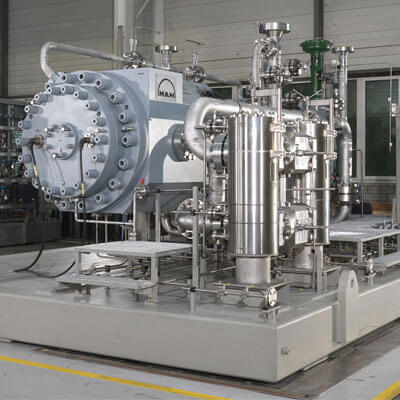Compressors
Compressors are similar to pumps, both increase the pressure on a fluid and both can transport the gas or air through a pipe.
We’ll cover what each is best used for below, so you can make an informed decision for your project.
Positive Displacement Compressors
Positive displacement compressors encompass a variety of different air compressors that generate power via air displacement. Air compressors in this category work with different internal mechanisms, but the principle for each is the same. A cavity inside the machine stores the air brought from outside and then slowly compresses the cavity to increase the air pressure and potential energy.
Rotary Screw Compressors
A common type of displacement compressor, rotary screw compressors are some of the easiest types of air compressors to take care of, as they are equipped with an internal cooling system and don’t require much maintenance. They are typically large, industrial-sized machines that can be either lubricated with oil or run oil-free.
Rotary screw air compressors generate energy via two internal rotors that turn in opposite directions. The air gets trapped between the two opposing rotors, and builds up pressure within the housing. Because of the internal cooling system, these air compressors are designed for continuous use, and range in power from 5 horsepower up to 350 horsepower.
Reciprocating Compressors
Another popular type of displacement compressor is the reciprocating compressor. These are typically found at smaller work sites such as garages and home construction projects. Unlike the rotary screw compressor, the reciprocating compressor is not designed for continuous use. A reciprocating air compressor has more moving parts than a rotary screw compressor, and these parts are lubricated with oil for smoother movement.
These types of air compressors work via a piston inside a cylinder, which compresses and displaces the air to build pressure. Reciprocating compressors can come in single or multi-stage variations, which affects the pressure ranges they can achieve.
When you need more power, the multi-stage compressor is the way to go. While single-stage compressors will get the job done for smaller projects such as woodworking and metalworking, multi-stage compressors provide the power needed for intense construction, such as auto assembly and maintenance. Multi-stage reciprocating compressors can reach up to 30 horsepower.
Dynamic Compressors
Dynamic air compressors generate horsepower by bringing in the air with rapidly rotating blades and then restricting the air to create pressure. The kinetic energy is then stored as static within the compressor.
Axial Compressors
Axial air compressors are not typically used in construction projects but are instead found in high-speed engines on ships or planes. They have a high-efficiency rate but are much more expensive than other types of air compressors, and can get up to many thousands of horsepower, which is why they are mainly reserved for aerospace research.
Centrifugal Compressors
Centrifugal air compressors slow and cool the incoming air through a diffuser in order to build up potential energy. Because of the multi-phase compression process, centrifugal compressors are able to produce a high amount of energy in a relatively small machine.
They require less maintenance than the rotary screw or reciprocating compressors and some types can produce oil-free air. They are typically used for more demanding construction sites such as chemical plants or steel manufacturing centers, as they can reach around 1,000 horsepower.
Brands
Aerzen, Howden, Danfoss, Copeland,...























